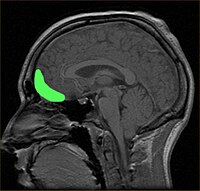
Photo from wikipedia
The ability to flexibly regulate our behavior is a fundamental feature of human cognition and requires efficient functioning of cognitive control. During movement preparation, proactive inhibitory control plays a crucial… Click to show full abstract
The ability to flexibly regulate our behavior is a fundamental feature of human cognition and requires efficient functioning of cognitive control. During movement preparation, proactive inhibitory control plays a crucial role in regulating the excitatory activity carried out by alertness. The balance between alertness and proactive inhibition could be altered in people with motor impulsivity trait, determining the typical failure in the inhibition of prepotent motor responses. To test this hypothesis, 36 young adults were administered the Barratt Impulsiveness Scale to assess motor impulsivity trait and underwent fMRI acquisition during the execution of an event‐related Go/Nogo task. To investigate motor preparation processes, we analyzed the “readiness” period, in which subjects were waiting and preparing for the upcoming stimulus (Go or Nogo). We found a positive significant correlation between motor impulsivity scores and the activation of left sensorimotor cortices. This result indicates that motor impulsivity trait might be associated with a disinhibition of the motor system, characterized by a diminished reactivity threshold and a reduced control over covert urges. Furthermore, we observed a positive significant correlation between motor impulsivity scores and the activation in left inferior and superior parietal lobule, which might be related to a more pronounced proactive control, probably reflecting a compensatory mechanism implemented by participants with a higher degree of motor impulsivity trait to reach a correct inhibition. Current findings provide a rationale for further studies aiming to better understand proactive control functioning in healthy impulsive subjects and under clinical conditions.
Journal Title: European Journal of Neuroscience
Year Published: 2019
Link to full text (if available)
Share on Social Media: Sign Up to like & get
recommendations!